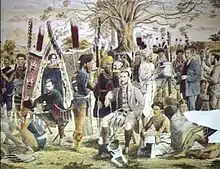| Languages | |
|---|---|
| Tenyidie, Keyho, Dzu-o (Sino–Tibetan) | |
| Religion | |
| Christianity (98.22%), Pfütsana (0.71%).[1] | |
| Related ethnic groups | |
| other Naga Ethnic Groups |
The Angamis are a major Naga ethnic group predominantly inhabiting the Kohima District, Chümoukedima District and Dimapur District in the Northeast Indian state of Nagaland.[2]
Culture

Cuisine
Galho is a popular Angami cuisine made from a mixture of rice, vegetables and various meats. It uses different kinds of ingredients such as Rice, Chinese knotweed, Pork or Beef, various vegetables and so on.[3][4]
Religion
Other religions
Although more than 98% of the Angamis are Christians, they are one of the last Naga ethnic groups having an animist population. The Angami animists practice a religion known as Pfütsana. According to the 1991 census, there were 1,760 Angami practitioners, but 10 years later the figure had halved to 884.[5] Currently there are several hundred adherents of the Pfütsana religion, scattered in nine villages of the Southern Angami region of Kohima District.[6]
Festivals
Sekrenyi
The Angamis celebrate a ten-day festival called Sekrenyi[7]
Te–l Khukhu
Te–l Khukhu is a festival that falls on 13th of Chünyi (July). It is a time of giving and sharing of food with each other. This is the only festival dedicated for girls. Gone were the days when different animistic rituals were performed but with the advent of Christianity the rituals were no longer performed. Today it is celebrated as a time of get-togetherness and sharing with the dear and near ones.[8]
Notable people
Gallery
 Angami Naga girl in her traditional attire
Angami Naga girl in her traditional attire
See also
References
- ↑ Table ST-14, Indian Census of 2001
- ↑ "The Constitution (Scheduled Tribes): Order, 1950". Ministry of Law and Justice (India). Archived from the original on 20 September 2017. Retrieved 23 April 2015.
- ↑ "Naga cuisine: Organic is a way of life for Nagas". Indian Express. 3 April 2018. Retrieved 4 May 2022.
- ↑ "Recipe of Galho – Yummy Rice Dish from Nagaland". Roots and Leisure. 30 July 2017. Retrieved 4 May 2022.
- ↑ Table ST-14, Table ST-14a, Census of India 2001
- ↑ "nscn: Japfuphiki Pfutsana annual feast". Nscn.livejournal.com. 26 March 2006. Retrieved 10 June 2014.
- ↑ "Festival of Angami Naga". Nagaland.nic.in. Archived from the original on 20 June 2014. Retrieved 10 June 2014.
- ↑ "Viswema celebrates Te–l Khukhu festival". Eastern Mirror Nagaland. 7 July 2017. Retrieved 22 December 2020.
Further reading
- Alban von Stockhausen: Imag(in)ing the Nagas: The Pictorial Ethnography of Hans-Eberhard Kauffmann and Christoph von Fürer-Haimendorf. Arnoldsche, Stuttgart 2014, ISBN 978-3-89790-412-5.
- Durkheim, E. and Mauss, 1963. Primitive Classification. (trans. R. Needham), London, Free Press.
- Edsman, C.M., 1987. 'Fire', The Encyclopaedia of Religion, vol. 5, ed. by M. Eliade. pp. 340–46. New York, Macmillan Publishing Company.
- Hutton, J.H., 1969. The Angami Nagas, Bombay, Oxford University Press. (first published in 1921 by Macmillan & Co. London).
- Joshi, Vibha. A Matter of Belief: Christian Conversion and Healing in North-East India (Berghahn Books; 2012) 298 pages; a study of Christian conversion and the revival of traditional animist culture among the Angami Naga.
- Rudhardt, J., 1987. 'Water', The Encyclopaedia of Religion, vol. 15, ed. by M. Eliade, pp. 350–61. New York, Macmillan Publishing Company.
- Stirn, Aglaja & Peter van Ham. The Hidden world of the Naga: Living Traditions in Northeast India. London: Prestel.
- Oppitz, Michael, Thomas Kaiser, Alban von Stockhausen & Marion Wettstein. 2008. Naga Identities: Changing Local Cultures in the Northeast of India. Gent: Snoeck Publishers.
- Kunz, Richard & Vibha Joshi. 2008. Naga – A Forgotten Mountain Region Rediscovered. Basel: Merian.
- Jonathan Glancey.2011.Nagaland- A journey to India's Forgotten Frontier :Faber and Faber .
